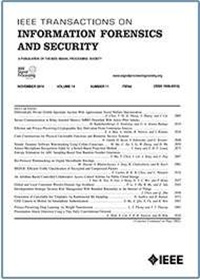基于信息隐藏的新型可见水印保护机制
IF 8
1区 计算机科学
Q1 COMPUTER SCIENCE, THEORY & METHODS
IEEE Transactions on Information Forensics and Security
Pub Date : 2025-07-24
DOI:10.1109/TIFS.2025.3592572
引用次数: 0
摘要
随着数字媒体的兴起,保护图像财产已成为一个关键问题。可见水印,曾经是版权保护的关键工具,越来越容易受到使用深度神经网络(dnn)去除方法的攻击。这对可见水印保护图像所有权和版权的能力构成了重大威胁。为了解决这一日益严峻的挑战,我们提出了一种新的基于信息隐藏的可见水印保护机制。与传统的直接在受保护图像中添加扰动的方法不同,我们通过一个特殊设计的可逆信息交换(RIE)模块来隐藏水印图像中的对抗性扰动,该模块包括多个离散小波变换(DWT)和仿射耦合块。这种设计可以将扰动集中在水印图像的纹理区域,使它们在视觉上不那么明显。同时,理论分析表明,本文方法生成的对抗图像(即嵌入对抗扰动后的水印图像)与水印图像的差值是完全可控的。为了在各种场景下评估所提出的机制,基于几个广泛使用的数据集(即LOGO-Gray, LOGO-H和LOGO-L),我们进一步合成了两个新的数据集,即LOGO-Multi和LOGO-Full。LOGO-Multi包含嵌入了多个水印的图像,而LOGO-Full包含嵌入了覆盖整个图像的水印的图像。在5个数据集上的大量测试表明,与基线方法相比,该方法可以大大提高对抗图像的视觉质量,增强其抵抗各种水印去除技术的能力。代码将在https://github.com/Aitchson Hwang/adversarial_visible_watermark获得。本文章由计算机程序翻译,如有差异,请以英文原文为准。
New Visible Watermark Protection Mechanism Based on Information Hiding
With the rise of digital media, protecting image property has become a critical issue. Visible watermarks, once a key tool for copyright protection, have become increasingly vulnerable to removal methods using deep neural networks (DNNs). This poses a significant threat to the ability of visible watermarks to protect image ownership and copyright. To address this increasingly severe challenge, we propose a novel visible watermark protection mechanism based on information hiding. Unlike traditional methods of directly adding perturbations to protected images, we hide adversarial perturbations in watermarked images through a specially designed reversible information exchange (RIE) module, which includes multiple discrete wavelet transform (DWT) and affine coupling blocks. This design can concentrate the perturbations on textured areas of the watermarked images, making them less visually noticeable. Meanwhile, theoretical analysis indicates that the difference between the adversarial image (i.e., the watermarked image after embedding the adversarial perturbation) generated by our method and the watermarked image is completely controllable. To evaluate the proposed mechanism in various scenarios, based on several widely used datasets (i.e., LOGO-Gray, LOGO-H, and LOGO-L), we further synthesize two new datasets, namely LOGO-Multi and LOGO-Full. LOGO-Multi contains images embedded with multiple watermarks, and LOGO-Full contains images embedded with a watermark covering the whole image. Extensive testing on five datasets demonstrates that, compared to the baseline methods, the proposed scheme can greatly improve the visual quality of adversarial images and enhance their capability to resist various watermark removal techniques. Code will be available at https://github.com/Aitchson Hwang/adversarial_visible_watermarking .
求助全文
通过发布文献求助,成功后即可免费获取论文全文。
去求助
来源期刊

IEEE Transactions on Information Forensics and Security
工程技术-工程:电子与电气
CiteScore
14.40
自引率
7.40%
发文量
234
审稿时长
6.5 months
期刊介绍:
The IEEE Transactions on Information Forensics and Security covers the sciences, technologies, and applications relating to information forensics, information security, biometrics, surveillance and systems applications that incorporate these features
 求助内容:
求助内容: 应助结果提醒方式:
应助结果提醒方式:


